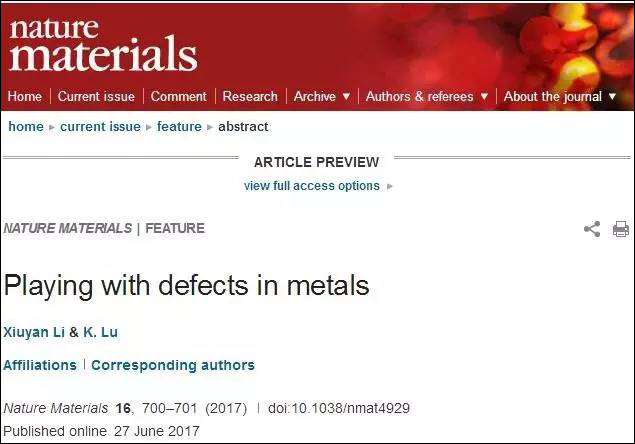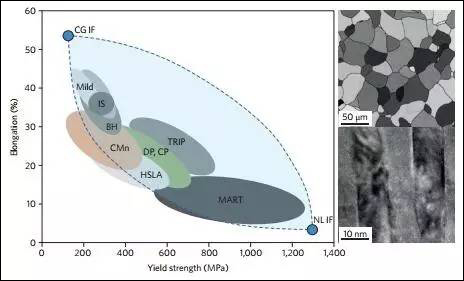近期,中国科学院金属研究所沈阳材料科学国家(联合)实验室研究员卢柯和李秀艳(共同通讯作者)关于材料素化的战略研究成果Playing with defects in metals 在《自然-材料》(Nature Materials)发表。
论文链接:
http://www.nature.com/nmat/journal/v16/n7/full/nmat4929.html

材料素化是卢柯近年来在对材料科技发展趋势的综合研究分析下提出的新概念。多年来,材料,尤其是金属材料的发展依赖于合金化来调节材料性能,但合金化在很多体系中的发展潜力将尽,而且合金化也加重了人们对自然资源的依赖。
材料素化指通过跨尺度构筑与组织结构调控,制造少合金化的“素”材料,大幅度提高材料的综合性能,实现不(或少)依赖合金化而调控材料的电子结构、晶格及相结构、形态与尺寸,以及界面表面结构等,减少或替代贵重、稀有或有毒元素的使用。
它为人们解决材料面临的可持续发展的以上难题提供了一个全新的思路。文中指出,实现材料素化的关键是有效控制材料中的各类缺陷,这一点材料科学研究仍有很长的路要走。
全文只有一张图片,如下所示:

Figure 1 | A range of mechanical properties that can be obtained by engineering defects in metals. Strength–ductility correlations for different types of steels. IS, isotropic; BH, bake-hardening; CMn, carbon-magnesium; HSLA, high-strength–low-alloyed; DP, dual-phase; CP, complex-phase; TRIP, transformation-induced plasticity; MART, martensitic; IF, interstitial-free. Coarse-grained (CG) IF steels (a scanning electron microscopy image of their morphology is shown in the top right) are soft and ductile. Nanolaminated (NL) IF steels (a transmission electron microscopy image9 of this morphology is shown in the bottom right) are very hard but less ductile. Gradient nanostructures combining these two extreme morphologies provide a broad range of strength–ductility combinations as outlined by the dashed lines. X.C. Liu is acknowledged for support in preparing the figure. Adapted from ref. 10, Wiley (graph); and ref. 9, Elsevier (right images)。
— END —
更多关于材料方面、材料腐蚀控制、材料科普等方面的国内外最新动态,我们网站会不断更新。希望大家一直关注中国腐蚀与防护网http://www.ecorr.org
责任编辑:王元
投稿联系:编辑部
电话:010-62313558-806
中国腐蚀与防护网官方 QQ群:140808414
免责声明:本网站所转载的文字、图片与视频资料版权归原创作者所有,如果涉及侵权,请第一时间联系本网删除。

官方微信
《中国腐蚀与防护网电子期刊》征订启事
- 投稿联系:编辑部
- 电话:010-62316606-806
- 邮箱:fsfhzy666@163.com
- 中国腐蚀与防护网官方QQ群:140808414





